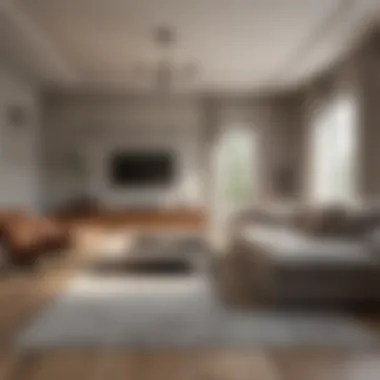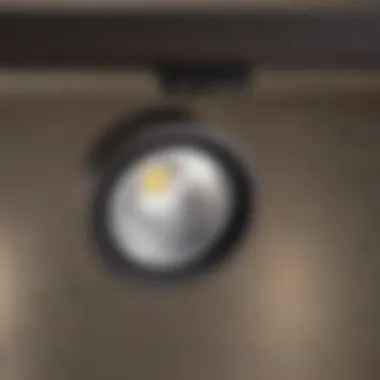Exploring Low Profile Track Lighting Design and Uses


Intro
Low profile track lighting has emerged as a popular choice for modern interiors. Not only does it captivate the eye, but it also serves a practical purpose in enhancing the functionality and aesthetics of any room. Imagine sleek lines illuminating your artwork or providing focused light for a reading nook—this versatile lighting solution hits the nail on the head for many homeowners, designers, and DIY enthusiasts alike.
As we delve deeper, we will explore not only the practical applications of low profile track lighting but also its transformative impact on the spaces we inhabit. This guide seeks to unpack various aspects of low profile track lighting, from its design versatility and installation tips to maintenance and trend considerations. Buckle up, and let's plunge into the bright world of track lighting, where style meets substance.
Furniture Styles and Trends
When discussing low profile track lighting, it’s crucial to understand how it coexists with various furniture and design trends. The synergy between lighting fixtures and furniture styles can significantly enhance a room’s atmosphere.
Modern vs. Traditional: Understanding the Aesthetics
Modern aesthetics generally lean toward minimalism, favoring clean lines and simplicity. In contrast, traditional styles often embrace more ornate designs. Low profile track lighting can bridge these two worlds, acting as a focal point without overwhelming other elements.
- For Modern Spaces:
- For Traditional Spaces:
- Choose track systems with a sleek finish, like matte black or brushed nickel.
- Opt for LED bulbs that offer energy efficiency and longevity, a key selling point for contemporary design.
- Incorporate track lights with a vintage finish, adding character to an otherwise classic setting.
- Consider adjustable heads to direct light onto statement pieces, such as antique furniture.
By blending both styles, homeowners can create a space that feels both inviting and sophisticated.
Color and Material Trends: What's In and What's Out
The colors and materials used in low profile track lighting are guiding factors as well; trends continuously evolve. Right now, earthy tones like terracotta or beige are making a splash in interior design. Combining these hues with modern materials like aluminum or even artisanal glass can elevate your lighting scheme.
What's in:
- Warm Metals: Gold and brass finishes add a touch of elegance.
- Natural Materials: Wood accents reflect the growing trend towards sustainability.
What's Out:
- Harsh Fluorescents: They’ve lost favor for warmer, softer options.
- Cluttered Designs: Simple, streamlined options have taken precedence.
Furniture Care and Maintenance
Ensuring that your low profile track lighting remains in top shape is paramount for both longevity and optimal performance. After all, a dim or flickering light can spoil the mood of even the most stylish room.
Tips for Prolonging the Life of Your Furniture
- Regular Dusting: Dust can accumulate and impair fixture performance. Use a soft, dry cloth for this job.
- Check Connections: Loose connections can lead to flickering lights—tighten them routinely.
DIY Repair Hacks for Common Furniture Issues
Lighting issues don’t always require a professional tie-up. Here are a couple of DIY fixes:
- Replacing Bulbs: When a bulb goes out, ensure you replace it with a compatible type to maintain the integrity of the lighting.
- Adjusting Track Articulation: If the light isn’t directing properly, a minor adjustment can correct the angle and enhance illumination.
Remember: The right lighting can be the cherry on top when preparing your space for an occasion or a simple evening in.
As you navigate the rich world of low profile track lighting, understanding its compatibility with varied furniture styles and how to maintain it will serve you well, ensuring that your space not only looks good but feels right too. In the upcoming sections, we will dive further into installation considerations, energy efficiency, and the latest trends that keep this lighting choice shining bright.
Prologue to Low Profile Track Lighting
When you think about transforming a space, lighting often plays a key role. Low profile track lighting stands out as an elegant solution that combines function with aesthetics. It smoothly blends into various design schemes while offering adjustable and focused illumination. This flexibility makes it particularly valuable in settings where both style and utility are paramount.
Definition and Characteristics
Low profile track lighting can be defined as a lighting system that features a streamlined design, often mounted flush to the ceiling. Unlike traditional track lighting that might protrude more significantly, low profile options maintain a sleek silhouette, often making them a favorite in contemporary homes and offices. Typical characteristics include:
- Minimalist design: These fixtures are crafted to be less obtrusive, seamlessly fitting into the background of modern interiors.
- Directional lighting: The fixtures can be positioned for versatile illumination, allowing for focused light on artwork, workspaces, or other focal points.
- Energy efficiency: Many modern low-profile fixtures utilize LED technology, providing bright lighting without significant energy consumption.
Overall, they successfully balance visual appeal with practical lighting needs, making them an attractive choice for many homeowners and designers alike.
Historical Context
The concept of track lighting has undergone significant evolution over the years. Initially, track lighting systems gained popularity in the 1960s as a practical solution for galleries and museums, where focused lighting was essential for showcasing artwork. As the years went on, designers began to recognize the potential of track lighting in residential design.
In the 1990s, an influx of low profile designs emerged, capturing the interest of homeowners seeking solutions that did not dominate their ceilings. This evolution paralleled shifts in interior design trends towards minimalism and open floor plans, where clutter-free aesthetics became a central focus.
Today, low profile track lighting is recognized for its contribution to various styles - from industrial chic to minimalist sophistication. Designers appreciate its ability to complement rather than compete with other elements in a room, proving its timeless relevance.
Design Versatility of Low Profile Track Lighting


The design versatility of low profile track lighting is crucial in today's homes and commercial spaces. This adaptability allows homeowners and designers to harness lighting not just for functionality, but as a vital design element. One can easily see how these fixtures can complement various aesthetics, enhancing overall ambiance. Whether illuminating art pieces or general areas, low profile track lighting can elegantly merge with any interior design style, creating a harmonious environment.
Aesthetic Appeal
Low profile track lighting is not merely about brightness; its aesthetic contribution is significant. These fixtures often come in sleek designs that unobtrusively blend with ceilings while directing light exactly where it's needed. The minimalist approach of low profile designs emphasizes clean lines and simplicity. By utilizing fixtures that are close to the ceiling, one can avoid clutter and maintain an open feeling in a space. Additionally, fixtures can be found in various finishes – from matte black to polished chrome – enabling endless customization possibilities. This adaptability in design allows track lighting to pair well with paint colors, furniture textures, and overall room themes.
Adaptation to Various Styles
Modern
Modern interior design champions simplicity, with a dash of sophistication. Low profile track lighting fits perfectly into this genre, providing the illumination needed without overwhelming the space. Characteristically, modern designs favor neutral colors and geometric shapes. Using track lighting with clean, straight lines underscores this aesthetic. Its unobtrusive nature helps create a sense of spaciousness, making it exceptionally beneficial for modern homes. However, designers must be careful not to overuse it, as too much minimalism can leave a room feeling stark or cold.
Industrial
Industrial style is known for its raw, unfinished look. The use of exposed elements like ductwork and concrete is prevalent. Low profile track lighting enhances this rugged charm. Fixtures with an industrial finish – such as matte metals or vintage bulbs – can emphasize the rough edges of a room. This style is popular among those who appreciate a blend of functional and aesthetically pleasing design. On the downside, finding the right balance is essential. Overly ornate fixtures can clash with industrial design, making restraint a necessary consideration.
Minimalist
In the realm of minimalism, every element must count. Low profile track lighting serves as a perfect partner in this pursuit. It concentrates on functionality while keeping design elements to a minimum. The main characteristic of minimalism is the elimination of excess. Track lighting systems can focus light with precision, avoiding distractions. A boon for those who seek simplicity in their living spaces. However, a cautious approach is warranted as too much focus on minimalism may render a space uninviting or too clinical if not complemented by warm textures or colors.
"Design is not just what it looks like and feels like. Design is how it works." - Steve Jobs
Ultimately, the design versatility of low profile track lighting allows it to adapt gracefully across diverse interior styles, whether modern, industrial, or minimalist. Understanding each style's uniqueness really helps illuminate the various ways in which these lighting systems can enhance visual experiences in our homes and workplaces.
Functional Applications
The functional applications of low profile track lighting are crucial to understanding its role in modern interior design. This type of lighting serves not merely aesthetic purposes; it plays a significant role in enhancing the functionality of various spaces within a home or commercial environment. When it comes to illuminating areas effectively, low profile track lighting proves beneficial in settings like living spaces, kitchens, and offices. Each of these areas demands specific attention to how light is directed and used.
Lighting for Different Spaces
Living Areas
In living areas, track lighting can provide versatility in brightness and mood. The ability to adjust the angles of the lights allows homeowners to direct illumination toward artwork, bookcases, or cozy reading nooks. This flexibility is a blue ribbon feature, enabling individual preferences in lighting according to the time of day or occasion. For instance, choosing warm LED bulbs complements the inviting atmosphere typically sought in these spaces.
However, it does come with a potential downside; if not installed correctly, the intensity of direct lighting can create shadows that are less flattering. The trick lies in finding that sweet spot of brightness that enhances comfort while minimizing harsh contrasts.
Kitchens
Kitchens require functional lighting that ensures safety and efficiency. Here, low profile track lighting excels by providing well-distributed light across work surfaces. When chopping vegetables or reading recipes, shadows can hinder performance. Thus, having lights that can be adjusted over countertops becomes a game-changer. An extra perk is that the sleek design of low profile lights can make a kitchen appear more spacious, a beneficial attribute for those with limited space.
On the flip side, you need to be careful about glare. A kitchen should be a no-stress area, and over-bright lights can create glare that is bothersome when preparing meals. Selecting fixtures with appropriate diffusion can counteract this problem quite effectively.
Offices
In the realm of offices, the demand for effective task lighting is paramount. Good lighting can enhance productivity and reduce eye strain, making low profile track lighting a wise investment. With adaptable settings, lights can be repositioned to focus on desks or collaboration areas. A well-lit office environment is proven to assist in maintaining alertness and concentration.
One major characteristic of office lighting that often gets overlooked is energy efficiency. Using LED fixtures in track systems can lead to significant savings on energy bills while contributing to a sustainable workplace environment. As tech-savvy designs become the norm, the adaptability of track lighting aligns seamlessly with modern office aesthetics. However, it’s essential to balance brightness levels; too much light can cause distractions.
Task Lighting versus Ambient Lighting
When discussing lighting applications, it’s important to differentiate between task lighting and ambient lighting. Task lighting refers to concentrated lighting meant for specific tasks like reading or cooking, offering clarity and precision. Low profile track lighting shines here as it can direct light exactly where it’s needed. Conversely, ambient lighting sets the overall mood of the space without necessarily focusing on specific areas. Using fixtures that offer both functions in a single design can enhance flexibility, allowing users to tailor their lighting experience according to their needs.
In summary, functional applications of low profile track lighting significantly affect how spaces are utilized, enhancing the atmosphere while fulfilling practical requirements. These elements are indispensable in any design scenario, making the understanding of their characteristics essential.
Technical Aspects
Understanding the technical aspects of low profile track lighting is essential for anyone looking to make informed decisions, whether you're a homeowner, a designer, or even a DIY enthusiast. These systems aren't just about aesthetics; they involve key components that determine functionality, efficiency, and overall performance in various settings.
Understanding Track Systems
Track lighting systems consist primarily of two components: the track and the fixtures. The track is the backbone of the entire setup, essentially acting as the highway for the lights you install. An important point to note is how tracks come in two types: single-circuit and multi-circuit. A single-circuit system allows you to control all lights simultaneously, while a multi-circuit system allows for more flexibility. This means you can tailor the mood in a room by dimming some lights while keeping others bright—fantastic for creating atmosphere.
When planning your layout, consider the length and configuration of the track. You might want straight runs, curves, or even T-shapes depending on the room’s architecture. Adjustability is another feature to pay attention to; tracks can be mounted at different angles or heights. Ultimately, the versatility offered by track systems makes them fit for diverse environments, from cozy living rooms to bustling galleries.
Types of Fixtures and Bulbs
The choice of fixtures and bulbs can drastically influence energy consumption and lighting quality. Let's break it down:
LED
LED bulbs stand out in track lighting as the epitome of energy efficiency. They are known for their long lifespan and low energy consumption, which translates into reduced electricity bills. What makes LED a great pick is its versatility—available in various colors and designs, it can easily fit into any decor. Plus, they emit very little heat, reducing the risk of fire hazards. However, one caveat is that some LED fixtures may produce a cooler light that doesn't appeal to everyone, though options exist to create a warmer ambiance.
Halogen


Halogen bulbs are a refined form of incandescent lighting that bring a warm, pleasing glow to any space. One significant aspect is their ability to dim down smoothly without compromising on brightness. This feature allows for tailored lighting solutions, making halogen excellent for creating a cozy vibe during evening gatherings. However, there's a downside; they tend to get quite hot, which can be a safety concern, especially in tight spaces. Users should be cautious with placement to avoid any potential hazards.
Incandescent
Incandescent bulbs have been a staple in the lighting world, appreciated for their warm light and excellent color rendering. They are straightforward to replace and typically less expensive than other bulbs. However, they consume a significant amount of energy compared to LEDs and halogens. This makes them a less ideal choice if energy efficiency is a priority. Despite this, their timeless quality can add a nostalgic charm to residential interiors. If you're an enthusiast seeking that old-school feel, incandescent might feel just right, even if it's not the most economical choice in the long run.
"The simplicity of track lighting offers a clean solution without overwhelming the interior design scheme."
In summary, choosing the right track system and lighting options plays a pivotal role in the overall effectiveness and aesthetic of low profile track lighting. Be it for energy savings, durability, or ambiance, each type of fixture has its own take on enhancing your living space.
Installation Considerations
When it comes to low profile track lighting, installation is not just a technical detail; it’s a pivotal aspect that can elevate or diminish the overall ambiance of a space. Understanding the nuances of installation ensures that your lighting is not only functional but expressive of your design aesthetic as well.
Designing the Lighting Layout
Designing an effective lighting layout involves planning where each track fixture will be placed for optimal illumination. Consider the purpose of the area; is it for general lighting or specific tasks? Position your light sources in a way that accentuates the best features of a room. This may include highlighting artwork, drawing attention to architectural elements, or providing sufficient illumination for reading or dining.
Some tips to bear in mind include:
- Scale and proportion: Make sure the scale of the lighting suits the size of the room. Oversized fixtures in small spaces can feel overwhelming, while tiny lights in expansive areas may go unnoticed.
- Light layers: Incorporate various layers of lighting; combine ambient, task, and accent lights to create a well-rounded effect.
Mounting Options
The choice of mounting options can significantly affect the style and functionality of low profile track lighting.
Ceiling-Mounted
Ceiling-mounted track lighting is a standout favorite among homeowners and designers alike. Its key characteristic is its unobtrusive design, allowing maximum ceiling height and seamless integration into any room. This option is particularly effective in spaces with lower ceilings, where lighting should enhance rather than obstruct.
Its advantages include:
- Reduced clutter: Total nearness to the ceiling helps maintain an open feel, making the room appear more spacious.
- Versatile positioning: The fixtures can be adjusted easily along the track, giving you the power to direct light where needed—perfect for multi-purpose rooms.
However, it’s important to consider the potential drawbacks as well. If not positioned properly, you could create harsh lighting or unwanted shadows that affect the ambiance.
Wall-Mounted
On the flipside, wall-mounted options provide a unique character that ceiling installations may lack. They are particularly useful in highlighting vertical spaces, like walls adorned with art or decorative features. The key characteristic here is their ability to draw the eye upward, creating a dramatic effect without overwhelming the space with fixtures.
- Accent focused: Ideal for showcasing objects or particular sections of a room, wall-mounted lights can create focused lighting zones.
- Design flexibility: They can serve as functional decor, merging art and utility seamlessly.
Yet, this approach has its own considerations. Wall-mounted track fixtures may limit adjustments compared to ceiling-mounted options, and misalignment can result in light cast in undesirable directions.
Impact on Interior Design
Low profile track lighting has evolved into a staple for contemporary interior design. Its significance extends beyond mere illumination; it shapes the ambiance and enhances the overall aesthetic appeal of a space. This type of lighting offers versatility that can adapt to various design themes, enabling homeowners and designers to craft personalized environments that reflect individual taste. The ability to manipulate light and shadow plays a crucial role in how spaces are perceived, making lighting selection a cornerstone of effective design.
Enhancing Spatial Perception
One of the most compelling benefits of low profile track lighting is its capacity to enhance spatial perception. By strategically positioning tracks and lights, designers can create the illusion of height and depth, making rooms feel larger and more open. For instance, running track lighting along the edges of a ceiling can direct focus upward, drawing the eye away from cramped corners and visually expanding the room.
- Use of Directional Lighting: Lights that can be angled or directed towards specific areas not only highlight artwork or architectural features but also guide movement through a space. This technique fosters a more immersive experience, encouraging individuals to explore and appreciate different aspects of a room.
- Layered Lighting Design: Integrating low profile track lighting with other forms of illumination like floor lamps and pendant lights helps etch out different zones within a space. This layering introduces contrast and depth, making even small areas feel dynamic and inviting.
Moreover, track lighting can serve to define and enhance focal points in an interior. Whether illuminating a gallery wall, a cozy reading nook, or a sleek kitchen counter, the right lighting accentuates texture, color, and form, captivating attention and enhancing style. The art of light manipulation, especially in confined spaces, can transform even the most mundane corners into visual catchments, altering perceptions and encouraging engagement with the environment.
Balancing Light and Shadow
While too much light can wash out a space, an absence can render it cold and uninviting. Low profile track lighting strikes an essential balance between light and shadow, creating depth and dimension. This delicate interplay invites a dynamic contrast, enlivening corners and adding layers to the experience of a room.
- Creating Ambiance: Carefully placing lights to cast soft shadows contributes to a warm and inviting atmosphere. For example, directing light away from pathways and towards textured walls or furnishings creates an enveloping glow that encourages relaxation and social interaction.
- Highlighting Architectural Features: Shadows can enhance architectural details, guiding the eye along lines and contours. When track lights are placed above or angled to illuminate ceiling beams or wall moldings, they highlight these features without overshadowing them. This results in a balanced and harmonious flow where every design element has a place in the narrative.
Through a thoughtful mix of light and shadow, low profile track lighting can transform interiors from simple spaces into sophisticated environments that tell a story. The ability to control both aspects not only maintains visual interest but also emphasizes functionality, ensuring that each area serves its intended purpose while contributing to the overall design ethos.
"The right use of light can make a space feel ten times more inviting; it’s about creating an experience, not just a look."
For further insights about lighting's impact on design, check out Wikipedia on lighting, or explore discussions on Reddit about innovative approaches in home lighting.
Energy Efficiency and Sustainability
In today's world, where energy conservation and environmental responsibility are paramount, low profile track lighting presents a unique opportunity to enhance both functionality and sustainability within interiors. The significance of energy efficiency in lighting cannot be overstated. It's not just about reducing utility bills; it's about making choices that have a positive impact on our planet. This section dives into energy sources and the sustainable practices that shape the future of lighting.
Comparison of Energy Sources
When it comes to illuminating your space, the energy source you choose plays a vital role in overall efficiency. Here’s a breakdown of common energy types associated with low profile track lighting:
- LED: Light Emitting Diodes are the champion of the energy efficiency world. Offering long lifespans and minimal energy consumption, LEDs can last upwards of 25,000 hours. Although the initial cost might be steeper compared to other options, their longevity and savings on energy bills make them an economical choice in the long run.
- Halogen: A form of incandescent lighting, halogen bulbs deliver bright, vivid light. They are more efficient than traditional incandescent bulbs, but still don’t match the performance of LED in terms of energy use and lifespan. Generally, halogen bulbs can burn for about 2,000 hours, which is quite less than their LED counterparts.
- Incandescent: While once considered the norm, incandescent bulbs are known for their high energy consumption and shorter lifespans (about 1,000 hours). The trend is moving away from these in favor of greener options due to their inefficiency.


This comparison illustrates not only the efficiency of various energy sources but also highlights the necessity of choosing wisely based on both environmental and financial considerations.
Sustainable Practices in Lighting
Sustainability in lighting goes beyond simply picking energy-efficient bulbs. It encompasses a holistic approach to lighting design and installation. Here are some practices that should be embraced:
- Choose Smart Systems: Integrating your lighting with smart home systems can offer remarkable benefits. By using motion sensors or timers, unnecessary energy use can be avoided. When you leave a room, lights turn off automatically, saving wattage without effort.
- Utilize Natural Light: Consider how you can optimize natural lighting during the day. Strategically placed mirrors can help reflect light from windows, reducing the need for artificial lighting. This practice not only cuts down on energy but also enhances the warmth of your space.
- Recyclable Materials: When selecting fixtures, choose options made from recyclable materials. This practice not only reduces waste but can also influence the design aspect; many modern fixtures are crafted from eco-friendly components that boast sleek aesthetics.
- Regular Maintenance: Keeping track of your lighting systems ensures they operate at peak efficiency. Dust buildup can reduce light output without you even noticing. A simple cleaning routine can enhance performance and prolong the lifespan of your fixtures.
By adopting these sustainable practices, homeowners and designers alike can make meaningful changes that contribute to a more energy-efficient future.
"Investing in low profile track lighting not only enhances your space aesthetically but also signifies a commitment to sustainability and energy efficiency."
In summary, energy efficiency and sustainable practices in lighting are more than just trends; they represent a forward-thinking wave in interior design choices. As technology continues to evolve, low profile track lighting will remain a leading option for environmentally conscious consumers.
Maintenance and Care
Maintaining low profile track lighting is not just about keeping things looking good—it's about ensuring the longevity and optimal functionality of your lighting system. Over time, dust, grime, and fingerprints can accumulate, dulling the gloss of your fixtures and dimming the ability of bulbs to illuminate your space effectively. Therefore, understanding maintenance practices becomes essential for homeowners, designers, and DIY enthusiasts alike.
The benefits of regular maintenance extend beyond mere aesthetics. Clean and well-functioning lighting can enhance the overall atmosphere of a room, serving both practical and visual purposes. Additionally, it can save you money in the long run by prolonging the life of your bulbs and fixtures, minimizing the need for constant replacements.
Some specific considerations when it comes to maintenance include:
- Frequency of Cleaning: Regular dusting should suffice in most cases, but deeper cleanings should be conducted every few months depending on the environment—smoky or humid spaces may require more attention.
- Materials Used: Using appropriate cleaning products prevents damage. Avoid harsh chemicals that could corrode or scratch the surface.
- Safety Protocols: Always turn off the power before attempting any cleaning or maintenance task to ensure safety.
Understanding these elements will set the foundation for two crucial subtopics in maintenance—cleaning techniques and troubleshooting common issues.
Cleaning Techniques
Cleaning your low profile track lighting involves a step-by-step approach that protects the integrity of the fixtures while maximizing their shimmer. Here’s how you can go about it:
- Power Down: Before you start, always ensure the power to the circuit is turned off. An unexpected shock can ruin your day.
- Dusting: Use a microfiber cloth to gently wipe down the track and fixtures. This should be done regularly, at least once a month.
- Deep Cleaning: For a thorough clean:
- Bulb Care: Remove light bulbs before cleaning to prevent moisture damage. Wipe them with a dry cloth to avoid leaving behind any water residue.
- Care for the Fixtures: For metallic surfaces, a mixture of vinegar and water can bring back the shine. Again, ensure you’re cautious and don’t let the solution leak into electrical parts.
- Prepare a solution of warm water and mild soap.
- Dampen a cloth in the solution, wring it out thoroughly, and wipe down the surfaces.
- Avoid soaking fixtures or getting moisture in the electrical components.
"Regular cleaning not only enhances aesthetics but also improves lighting performance over time."
Following these cleaning techniques will keep your lighting system in top shape and aid in troubleshooting.
Troubleshooting Common Issues
Despite regular maintenance, you might run into issues with low profile track lighting. Many problems are simple to address, provided you understand the basics. Here are some common issues and potential fixes:
- Flickering Lights: A flickering bulb could be a sign of a loose connection. Ensure the bulb is seated properly in the socket. If the issue persists, check the wiring.
- Bubbles in Fixtures: Over time, some fixtures might accumulate a residue that looks like bubbles or blotches. Using the cleaning techniques previously mentioned can usually clear this up, but if the issue is severe, consider replacing the affected fixture.
- Burned Out Bulbs: Regularly check bulbs, especially if they’re flickering or dim. Keep replacements handy, and always choose the correct wattage.
- Heat Buildup: If the area around your track lighting feels excessively hot, it could be an issue with ventilation or wattage. Lower wattage bulbs or adjusting the layout to improve airflow might be necessary.
- Streaked or Cloudy Fixtures: This could stem from either poor cleaning technique or using the wrong products. Stick to mild soaps and avoid aggressive scrubbing to maintain clarity.
Addressing these issues promptly not only ensures safe and effective lighting but also enhances the overall functionality of your interior design.
Future Trends in Low Profile Track Lighting
As we step into an era characterized by rapid technological advancements, the domain of low profile track lighting finds itself at a pivotal juncture. This section examines the transformative trends shaping the future of track lighting, highlighting how innovation enhances user experience while aligning with contemporary design sensibilities. Embracing these trends not only allows individuals to elevate their living spaces aesthetically, but it also introduces functional improvements that cater to modern demands.
Smart Lighting Innovations
The advent of smart technology has revolutionized countless aspects of daily life, and lighting is no exception. In low profile track lighting, smart innovations stand out as a key trend. Today’s smart lighting solutions provide homeowners with unprecedented control over their environment. This control ranges from adjusting brightness levels to changing color temperatures, offering an array of options to suit moods and occasions.
- Customization: Programmable settings allow users to create tailored lighting scenarios that suit both gatherings and quiet evenings in.
- Remote Access: With mobile apps, one can control lights from virtually anywhere. This feature is especially handy for those leading busy lives or frequently traveling.
"Smart lighting isn't just about convenience; it's about creating a dynamic environment that responds to your needs."
Additionally, integration with voice assistants like Amazon Alexa or Google Assistant takes it a step further. Picture this: you're settled on the couch, and with just a simple command, your track lighting adjusts to the perfect setting for a cozy evening. This blend of functionality and style underlines a significant future trend, making homes more efficient and comfortable.
Integration with Smart Home Systems
The integration of low profile track lighting with broader smart home systems marks another crucial trend. Home automation systems are becoming increasingly popular, and lighting often assumes a central role in this mix. The possibility of seamless integration means that lighting management can communicate with other devices in the home, fostering a more cohesive living environment.
- Energy Management: Smart systems can help track energy consumption, allowing homeowners to monitor and adjust their usage effectively. This is increasingly important as energy efficiency becomes a priority for many.
- Enhanced Security: Automated lighting can serve as a deterrent against potential intruders. With smart track lighting, users can set schedules or activate motion sensors, ensuring that their homes are well-lit when they're away.
The trend toward interconnected systems emphasizes the growing awareness around safety, energy consumption, and convenience. Homeowners aren't just looking for lights—they're seeking holistic solutions that adapt to their lifestyles and enhance their overall quality of life.
Culmination
As we wrap up our extensive look into low profile track lighting, it's crucial to acknowledge how this unique lighting solution seamlessly integrates form and function in contemporary spaces. Today’s homeowners and designers alike seek lighting that not only illuminates but also enhances the aesthetic appeal of various environments. Low profile track lighting emerges as a strong contender, offering a delicate balance between style and practicality.
Summarizing Key Insights
When considering low profile track lighting, several key insights are vital to remember:
- Design Flexibility: Its versatility allows it to be adapted across various styles, from modern to minimalist settings.
- Functional Applications: Effectively utilized in different spaces such as kitchens, living areas, and offices, it provides tailored lighting solutions.
- Energy Efficiency: Opting for LED bulbs can significantly diminish energy consumption while enhancing illumination quality.
- Ease of Installation: The simplicity of installation, whether ceiling-mounted or wall-mounted, makes it accessible for DIY enthusiasts.
- Future Trends: The integration of smart technology into these lighting systems hints at an evolving landscape that meets modern demands.
"The thoughtful integration of low profile track lighting can transform an ordinary room into an extraordinary space, emphasizing key design elements while providing necessary illumination."
All these elements combined underscore the significance of low profile track lighting in interior design today. It's an investment that stands out not only for its operational efficiency but also for its ability to elevate living spaces aesthetically. As trends continue to evolve, embracing such innovations helps in crafting environments that are both stylish and functional.















